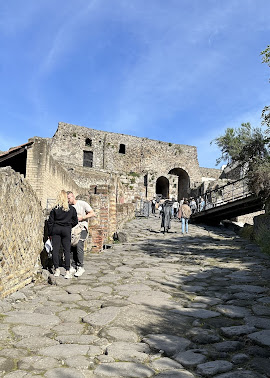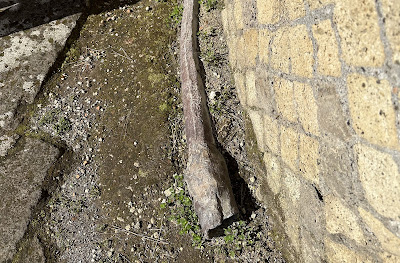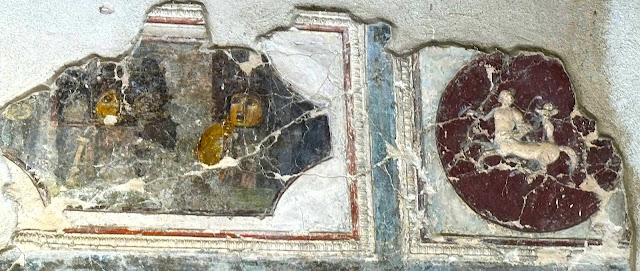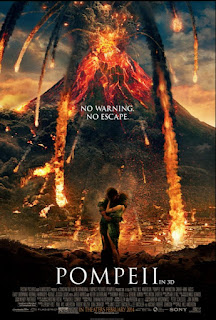March 15, 2024
One of the reasons we started our trip in Naples was because we wanted to visit the ancient city of Pompeii, the legendary city covered by ash for centuries before being discovered. To get to Pompeii from Naples, we took a train ride of about 40 minutes.
We were hoping to find a place to eat between the Pompeii station and the ruins. No problem. There was a line-up of five or six restaurants along the road that led to the main entry gate for the ruins. We chose a place with friendly staff, and (ironically, as this was a major tourist area) I had one of the better meals of the trip: gnocchi with cheese sauce and a wonderful pizza I shared with Bob.
The ruins were discovered in the late 16th century, but excavation didn't begin until 1750, over 150 years later. In 1763, during the excavations, an inscription was found that identified the site as Pompeii.
Our initial impression on walking in was already WOW! The UNESCO article on this site and its companion site Herculaneum (which my sister and BIL visited on the day they arrived before we got there) notes, "Pompeii and Herculaneum are the only Roman cities ruins preserved in such an exceptional way and have no parallels in integrity and extent in the world. [They] provide a full picture of Roman life from the 1st century BC to the 1st century AD through the urban, architectural, decorative and daily life aspects that have been preserved."
Part of the restoration process is making it obvious where there have been modern renovations..It's pretty amazing that after almost 2000 years, there is still this much color and detail in the frescoes.
Pompeii has five public bathing complexes, each with a complicated heating system to warm the water.
I think this photo shows one of the lead pipes that was part of the plumbing system:
The luxurious bathhouse for the wealthy had a nice view of daily life outside . . .
. . . and more colorful frescoes.
And here is the forum, a huge square bounded by the temple on the left side, with markets on the other side and a legislative building on a third side.
Zooming in on the far end of the photo above, we can see the Temple of Jupiter, built in the mid-2nd century BC when Rome was gaining power over the area, meaning that the Roman god Jupiter became more important than the Greek god Apollo.
Close-up of one of the weird pillars, reminiscent (or pre-figuring?) the Leaning Tower of Pisa.
Here is another one of those interesting walls with square bricks turned 90° to make diamonds.
I thought this was a pretty amazing statue, but then I learned it is part of an exhibition by Igor Mitoraj, a Polish sculptor who died in 2014. We have seen his work in front yard of the Minneapolis Institute of Art, on the doors of the Church of the Gracious Mother of God in Warsaw, Poland, and in the city square in Krakow, Poland. I love adding Pompeii to that list!
On the east side of the Forum is the Portico of Concordia Augusta (also known as the building of Eumachia, the priestess of Venus, an actual Pompeiian woman who was quite wealthy and powerful).
One of the most moving and simultaneously disturbing exhibits at Pompeii are what I thought were bodies that were essentially mummified by volcanic ash, but I have learned that they are actually modern plaster casts of the places where the bodies once were. As 19th-century excavators worked to uncover ruins, they began to notice strange holes and cavities, sometimes containing human remains. Lava once encased human bodies, but as those bodies decomposed, they left a void in the lava. Excavators figured out that they could pour plaster of Paris into the void to create a plaster cast that looked like the human body that once lay there.
That makes this figures in their glass cases just a little less creepy.
This reminded me a bit of the interior courtyard of the Getty Villa in Pacific Palisades, California. When I looked it up, I found the Getty courtyard was modeled after Pompeii's neighbor, Herculaneum, also buried in ash by the eruption on 79 AD.
The frescoes are unbelievably rich and vibrant after nearly two millenia.
There are pillars and sculptures everywhere, indications of the wealth of the residents.
Several broad, straight avenues crisscross the city, providing easy access to most side streets.
Below left: In contrast to the "Welcome" front door inscription depicted earlier, this menacing mosaic dog is embedded in the entrance to another villa, fondly known as "The House of the Tragic Poet" At the pooch's front feet is the Latin phrase cave canem - "Beware of the dog."
Below right: Terra cotta jars are inserted into a nicely tiled countertop in what was likely a shop or perhaps a restaurant. Maybe a salad bar???
I guess even ancient ruins need modern first aid facilities.
He stands near the almost totally destroyed sanctuary of Venus, the patron goddess of Pompeii.
About two-thirds of Pompeii has been excavated so far, and the archaeological and anthropological work will continue for years to come.
I was behind in the reading I had selected for this trip, so instead of reading a book about Pompeii, we decided to watch the 2014 movie Pompeii starring Kiefer Sutherland.
If you are looking for historical accuracy, this might not be your best choice. While it is fun to imagine what life and then death by eruption would have looked like in the ancient city, the story of a romance between a gladiator and a noblewoman is a bit far-fetched.
Kieffer Sutherland plays a nasty Roman general who kills the parents of a young boy who grows up to be the said gladiator. It was not his best performance.






































































(Bob) In many ways I thought our guide was better than the remains. He certainly added much to the remains and I think I concentrated more on what he was saying than what I was looking at. Pompeii is not what I thought it would be. I envisioned lots of colorful frescoes and white buildings. It did not have as many fine details as I expected. It was wonderful, but very different from what I imagined.
ReplyDelete